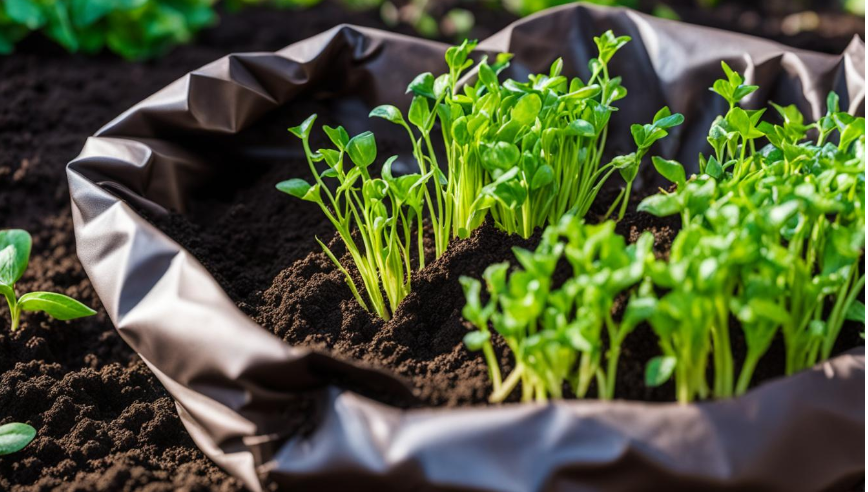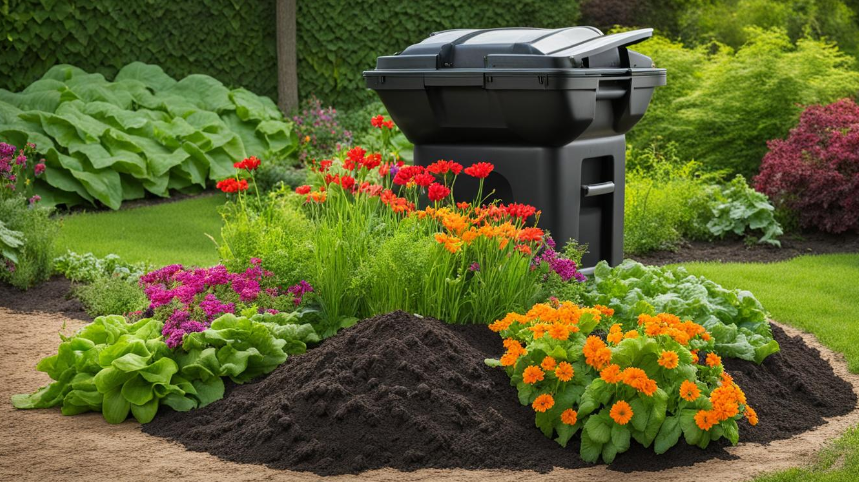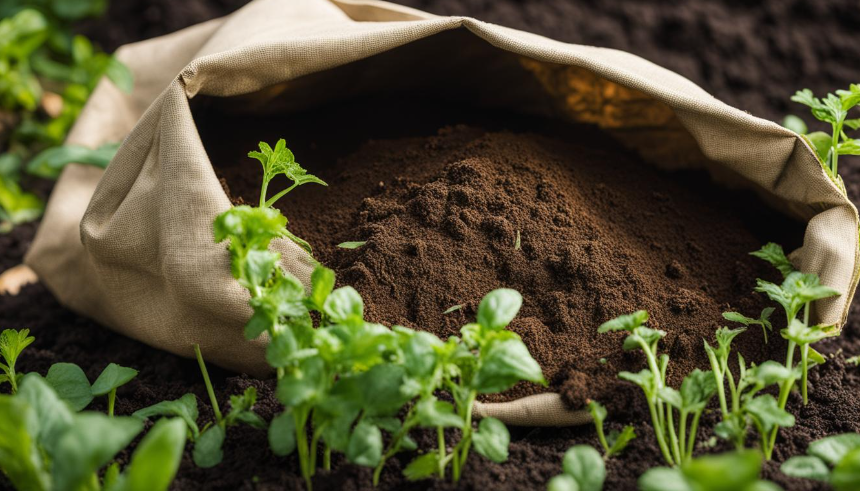Table of Contents
Composting is an effective way to reduce waste and help the environment. Composting bags provide an eco-friendly solution for backyard waste management. They are easy to use and have numerous benefits. In this article, we will guide you through the process of selecting, setting up, and maintaining a composting bag. By the end of this guide, you’ll be able to turn your backyard waste into nutrient-rich compost easily and efficiently.

A lush garden overflowing with vibrant flowers and vegetables, surrounded by trees swaying in the breeze. In the center of it all, a composting bag sits proudly, with a pile of nutrient-rich soil spilling out of it. The plants nearby appear healthier and more robust than those in other areas of the garden, with their leaves shining brighter and their colors more intense. In the distance, a group of people sit around a table sipping tea, laughing and chatting happily as they admire the greenery around them.
Key Takeaways
- Composting bags are an eco-friendly solution for backyard waste management.
- They are easy to use and have numerous benefits.
- By composting, you can reduce waste and help the environment.
- The right composting bag, location, and maintenance can help you achieve optimal results.
- Transform your backyard into a greener space by starting your composting journey today!
Understanding Composting Bags
If you’re looking for an eco-friendly way to manage your waste, composting bags are an excellent option. Composting bags are specially designed bags that you can use to compost organic waste, such as food scraps, leaves, and grass clippings.
Composting bags are a sustainable and easy way to reduce your environmental impact while producing nutrient-rich soil for your garden. They are typically made from biodegradable materials, making them an eco-friendly choice for waste management.
How Composting Bags Work
Composting bags work by creating an ideal environment for organic waste to break down into nutrient-rich soil. The bag contains all of the organic material and the microorganisms needed to break it down, allowing the composting process to occur in a contained space.
As the organic material breaks down, it produces heat and moisture, which are essential for the composting process. The microorganisms break down the organic material into smaller particles, creating rich soil that is perfect for gardening.
The Benefits of Composting Bags
Composting bags offer many benefits, including:
- Reducing waste sent to landfills
- Producing nutrient-rich soil
- Reducing greenhouse gas emissions
- Contributing to sustainable waste management practices
Composting also reduces the amount of methane gas produced by organic waste in landfills and reduces the need for harmful chemical fertilizers, making it a healthier and more sustainable option for your garden.

Create an image of an eco-friendly composting bag with rich and fertile soil inside. The bag should be made of natural materials and have a green color that represents sustainability. Show the bag in a garden or farm environment, surrounded by plants and vegetables that have grown from the compost generated inside the bag. The composting bag should be open and overflowing with rich soil, indicating its effectiveness in producing nutrient-rich compost. Use vibrant colors to showcase the life and fertility that the composting bag brings to the environment.
Eco-Friendly Waste Management
Composting bags are an eco-friendly solution for waste management. By composting your organic waste, you can reduce the amount of waste that ends up in landfills and contribute to a healthier environment. Composting bags are also made from biodegradable materials, making them a sustainable choice for waste management.
In the next section, we will guide you on how to choose the right composting bag for your needs, discussing the various materials available, the ideal size for different settings, and the important features to consider when making your choice.
Choosing the Right Composting Bag
Choosing the right composting bag is essential for optimal composting. With a wide range of composting bags available, selecting the right one can seem like a daunting task. In this section, we will guide you through the process of selecting the best composting bag to meet your needs.
Materials
The material of your composting bag is an essential factor to consider when making your selection. Composting bags are commonly made from materials like jute, cotton, and polypropylene. Polypropylene is a popular choice as it is durable, sturdy, and resistant to tears and punctures. However, if you are looking for eco-friendlier options, jute and cotton bags are biodegradable and compostable.
Size
The size of your composting bag will depend on the quantity of waste you intend to compost. For smaller households or those with limited outdoor space, a smaller bag is ideal. Larger households may require a bigger bag to accommodate their composting needs. Always consider the amount of waste you generate before selecting the size of your composting bag.
Features
Composting bags come with a variety of features that can enhance your composting experience. Some bags have built-in aeration systems that reduce the need for manual mixing, while others have reinforced handles for easy transport. When selecting your composting bag, consider the features that will make your composting experience more efficient and enjoyable.
Comparison Table
| Material | Size | Features |
|---|---|---|
| Polypropylene | Available in various sizes | Reinforced handles |
| Jute | Small to medium sizes | Biodegradable, compostable |
| Cotton | Small to medium sizes | Biodegradable, compostable |

A close-up of a composting bag filled with rich, dark soil overflowing with vibrant green sprouts and small leaves. The bag is made of a durable, eco-friendly material that allows air and moisture to flow through easily. In the background, there is a lush garden with various plants and flowers.
By considering the material, size, and features of your composting bag, you can select the right one to suit your individual needs. Remember that an effective composting bag can make all the difference in achieving successful composting.
Setting Up Your Composting Bag
Setting up your composting bag is a simple but essential step in ensuring effective composting. Following these steps will help you create a rich, nutrient-filled compost that will benefit your garden and the environment.
Finding the Ideal Location
Choosing the right location for your composting bag is crucial. Select a spot that is convenient for you and has good drainage to prevent waterlogging. Avoid placing your bag near trees or shrubs, as their roots may encroach into your compost.
If you are using a composting bag in an apartment or small space, a balcony or patio may be the ideal location. Make sure to choose a spot that is sheltered from the elements and has good airflow.
Preparing Your Composting Bag
Before setting up your composting bag, it is vital to prepare it properly. Begin by selecting the right size bag for your needs and checking that it is in good condition.
Next, add a layer of twigs or other coarse materials to the bottom of the bag. This will aid in drainage and improve aeration within the bag. Follow this with a layer of brown materials, such as dry leaves or straw, and then a layer of green materials, such as food scraps or grass clippings. Repeat this layering process until the bag is full, making sure to water each layer as you go.
Additional Steps for Optimal Composting
To speed up the composting process and ensure optimal results, consider adding a compost accelerator or activator. These products contain beneficial microorganisms that will help break down organic matter more quickly.
It is also important to regularly turn or mix the contents of your composting bag to promote even composting and prevent odors. You may need to add additional water or brown materials if the compost is too wet or too green, respectively.
Tip: To prevent attracting pests or rodents, avoid adding meat or dairy products to your composting bag.
Maintaining and Troubleshooting Your Composting Bag
Now that you have your composting bag set up and running, it’s important to maintain it properly to ensure a steady supply of nutrient-rich compost. Here are some tips for keeping your composting bag in top shape:
- Regularly turn and mix your compost: This will help it decompose evenly and prevent bad odors. Use a shovel or a compost turner to mix the contents regularly.
- Keep your compost moist: Your compost should be about as damp as a wrung-out sponge. If it’s too dry, add some water. If it’s too wet, add some dry leaves or paper to balance it out.
- Avoid adding meat, dairy, or oily foods: These items can attract pests and slow down the composting process.
- Monitor the temperature: As your compost breaks down, it will generate heat. Make sure the temperature stays between 110-160°F for optimal decomposition.
If you encounter any issues with your composting bag, here are some troubleshooting tips:
| Problem | Solution |
|---|---|
| Compost is too dry | Add more water or moist materials like fruit and vegetable scraps. |
| Compost is too wet | Add more dry materials like leaves, straw, or shredded paper. |
| Compost smells bad | Turn the compost more frequently and avoid adding meat, dairy, or oily foods. You can also add some lime or wood ash to balance the pH level. |
| Compost is not decomposing | Make sure your compost has enough air and moisture. Turn it more frequently and chop up larger pieces of materials to speed up the process. |
By following these maintenance and troubleshooting tips, you can keep your composting bag running smoothly and producing high-quality compost for your backyard. Happy composting!
Conclusion
Composting bags are a fantastic, eco-friendly way to manage waste and transform your backyard into a greener, more sustainable space. By selecting the right composting bag, setting it up properly, and maintaining it regularly, you can enjoy the many benefits of composting, from reducing your environmental impact to producing rich, nutrient-dense soil for your garden.
Remember, composting is a journey, and it may take time to perfect your technique and see the results you want. But with patience, dedication, and a commitment to sustainability, you can make a real difference in your own backyard and beyond. So why not start your composting journey today?
FAQ
What are the benefits of using a composting bag?
Composting bags provide a convenient and eco-friendly way to compost organic waste. They help reduce landfill waste and produce nutrient-rich compost that can be used in your garden or flower beds.
Are composting bags eco-friendly?
Yes, composting bags are made from biodegradable materials that break down naturally over time. They contribute to sustainable waste management and are a great alternative to plastic bags.
How do composting bags work?
Composting bags work by creating the ideal conditions for organic waste to decompose. The bag retains heat and moisture, promoting the growth of beneficial bacteria and fungi that break down the waste into nutrient-rich compost.
How do I choose the right composting bag?
When selecting a composting bag, consider the size, materials, and features that suit your needs. Choose a bag made from breathable materials, with a size that fits your composting area, and features like handles for easy transportation.
Where should I set up my composting bag?
Place your composting bag in a location that receives partial sunlight and is easily accessible. Avoid placing it directly on concrete or asphalt, as this can hinder the natural decomposition process.
How do I maintain my composting bag?
To maintain your composting bag, regularly add a balanced mix of green and brown materials, turn the contents occasionally to aerate them, and monitor moisture levels. Avoid adding diseased plants, meat, dairy, or oily substances.
What should I do if I encounter problems with my composting bag?
If you encounter problems such as odor, pests, or slow decomposition, adjust the balance of green and brown materials, ensure proper aeration, and monitor moisture levels. Troubleshooting tips can help resolve common issues.

Pingback: Composting 101: A Beginner's Guide to Easy Home Composting
Pingback: Apartment Composting: Easy Eco-Friendly Tips
Pingback: Organic Compost Tea Recipe for Healthy Gardens
It is the best time to make some plans for the future and it is time to be happy. I’ve read this post and if I could I want to suggest you some interesting things or suggestions. Perhaps you could write next articles referring to this article. I want to read even more things about it!
Only wanna input on few general things, The website design is perfect, the subject matter is very fantastic. “I have seen the future and it doesn’t work.” by Robert Fulford.
Magnificent goods from you, man. I have understand your stuff previous to and you are just extremely wonderful. I actually like what you have acquired here, certainly like what you’re stating and the way in which you say it. You make it enjoyable and you still care for to keep it wise. I can’t wait to read far more from you. This is really a wonderful website.
Thank you for sharing excellent informations. Your web site is very cool. I am impressed by the details that you’ve on this website. It reveals how nicely you perceive this subject. Bookmarked this web page, will come back for extra articles. You, my friend, ROCK! I found just the info I already searched everywhere and just couldn’t come across. What an ideal web site.
Good info. Lucky me I reach on your website by accident, I bookmarked it.
Normally I do not read article on blogs, but I would like to say that this write-up very forced me to try and do it! Your writing style has been surprised me. Thanks, quite nice article.
I have been reading out a few of your stories and i can claim clever stuff. I will surely bookmark your website.